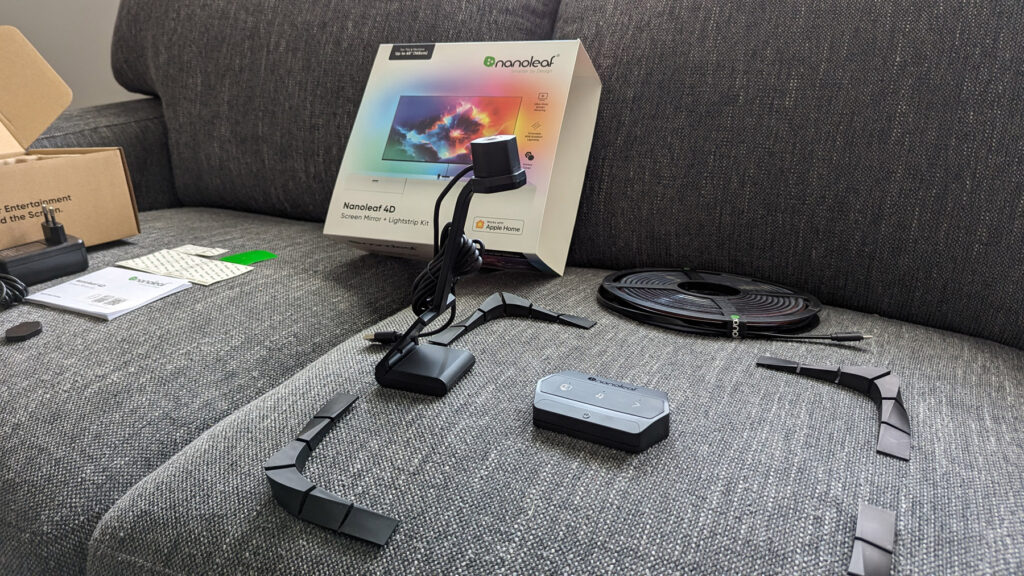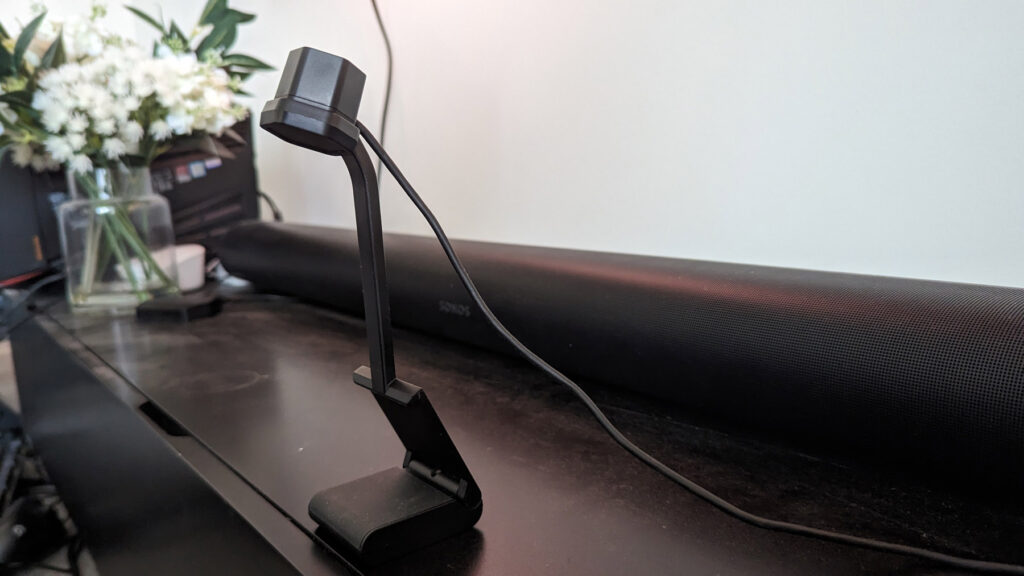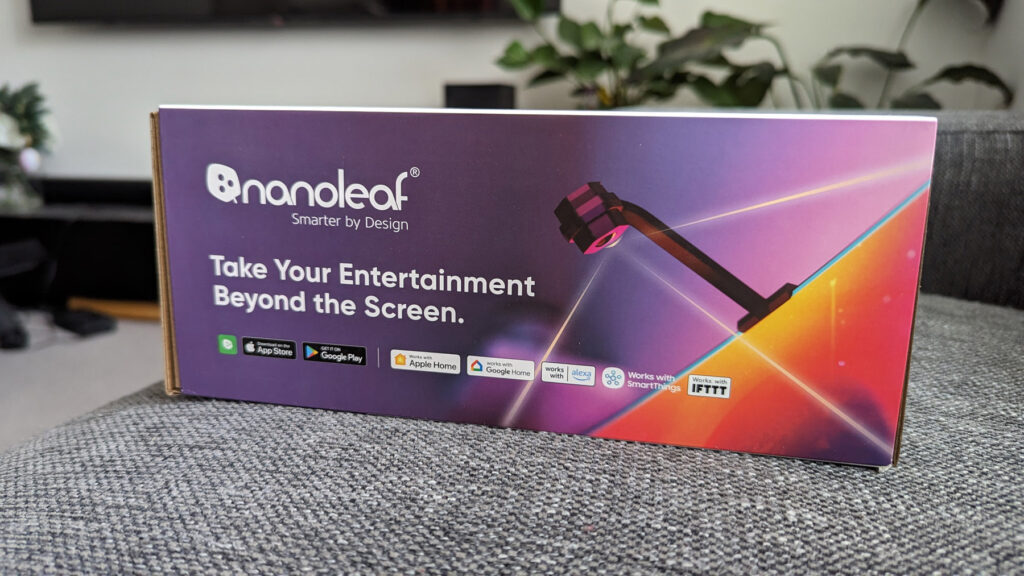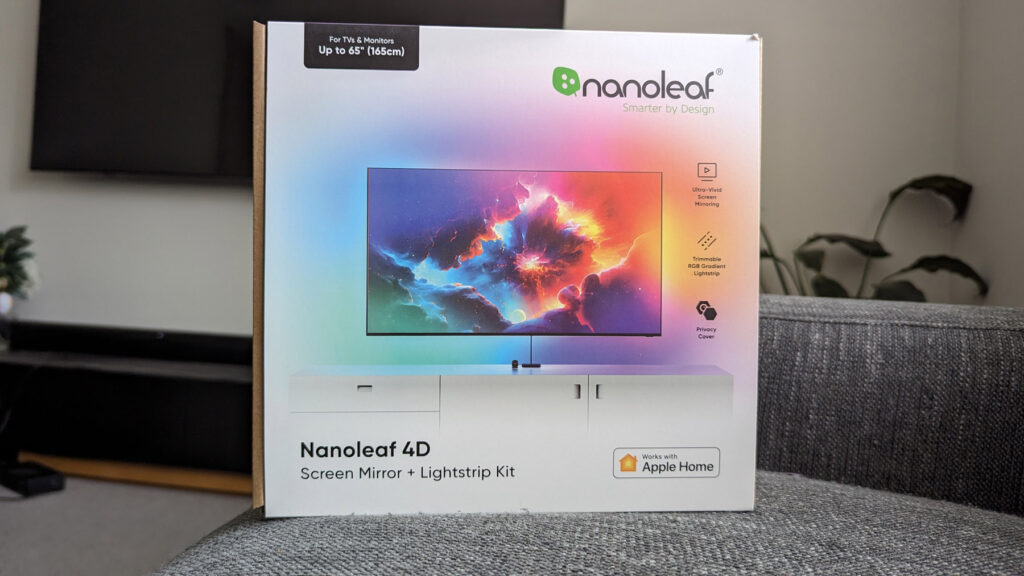Nanoleaf has a strong lineup of smart, connected lighting products and their newest is the Nanoleaf 4D Screen Mirror + Lightstrip Kit.
This product takes the content on your TV and extends it beyond the edges of the screen. This concept has been around for a while, I first experienced it back in 2016 with a Kickstarter called Lightpack, which was then followed by Philips who build it into TVs.
This product works in a different way, instead of capturing a single HDMI source, Nanoleaf offers a camera that monitors what’s on screen and translates that to the RGB values at the screen edges to the addressable gradient LED lightstrip mounted behind it.
Screen mirroring allows you to watch your favourite shows, and movies, or play video games, with vibrant backlighting illuminating the whole wall behind your display for a more immersive “4D” effect.
While the light strip included in the kit is trimmable, the version I got for review was designed for a 65″ display, however, I mounted it to my 75″ Samsung TV. I ran the light strip around an inch from the edge of the display and it perfectly reached, but if you apply it as expected, you may need to trim it.
The product comes in two sizes, Up to 65″ and Up to 85″ versions which I probably should be using the later on a display this size, but wanted the experience in the rumpus, rather than in our lounge room.
After having used the product for a few weeks now, it’s time to dive into a full review and let you know if you should buy the Nanoleaf 4D Screen Mirror and Lightstrip kit.












Design
The camera in this system can be mounted either on top or below the display to capture the colour values from the display. I tried both and was definitely more comfortable with the ‘above the tv’ option. This attaches to the top of the display using a similar technique that webcams use to rest securely in place.
On the back of the camera stand is a nice cable management channel to keep things tidy and if you’ve wall-mounted the TV, you’ll definitely want a power outlet behind the display to ensure you can hide all the cables out of sight.
One of the questions I had was which corner I should start mounting from and without guidance in the box, I guessed, starting at the lower-left corner, working up the left side, along the top, down to the lower right corner and back to the lower left. The process was pretty straightforward after first mounting the corner pieces which helps make the horizontal to vertical transitions.
Thankfully after mounting and going through the app setup, I realised that the start location actually doesn’t matter, as you get to configure the lightstrip in the app and tell it where each corner is, easily selectable with light emitting from each selected corner, you just rotate the dial in the app until the light matches the selected corner.

Features
The kit contains all the necessary components to deliver the screen mirroring experience, this contains a camera, the LED lightstrip, the controller, mounting brackets and power adapter.
The LED lightstrip is rated for as many as 25,000 hours, which means if you ran this 8 hours a day, you could do that for 8.5 years.
Being a Smart home, IoT product, it has a great ability to integrate with other connected products. Nanoleaf 4D lightsrip integrates with Apple Home, Amazon Alexa, Google Home, IFTTT, SmartThings, and Razer Chroma.
When it comes to the experience, something that can differentiate solutions is the resolution of the RGBs. Nanoleaf offers 30 LEDs per metre, which correlates to 10 colour zones per metre. While this will never match the resolution that a 4K TV offers, it does a great job of extending different colours on the screen outside the border.
Imagine the pixels at the edge of the screen are grouped into 10 zones, this allows the LED lights to be 10 different colours per meter, resulting in a more accurate extension of the image colours, than a lower resolution solution.
For this effect to work correctly, it not only has to have a high resolution, but also a fast response time and offer a wide range of colours. Thankfully both are true here and Nanoleaf has done a nice job of creating a compelling offering, even if setup does take a bit of work.


Issues
Over the years I’ve connected dozens of smart home products using connection technology under the sun. Some use Wifi, others use Bluetooth, some use QR codes, some use NFC and when a setup goes well it feels magical, but when it doesn’t and you see that dreaded ‘can’t connect’ or ‘device not found’ message, it is one of the most infuriating experiences customers can have.
I will preface this by saying I received the product early for review, and as such, the out-of-the-box experience that you will get wasn’t available to me. When you set up the product, you’re asked to scan the QR code with the Nanoleaf app. I did this and it continued to say the device wasn’t found.
The reason for this is the current Nanoleaf app in the store needs an update to be compatible with this new product. After some back and forward, I received a beta version of the Nanoleaf app (orange icon instead of green).
Again I fire up the app, go to add a device, scan the QR code on the back of the controller and again am told it can’t find the device. After a series of reboots of my phone, the power to the Nanoleaf product, and turning Airplane mode on and off, I finally managed to get the device to show up and connect.
After getting to the last step of the setup, it wanted to sync with the Nanoleaf Lightstrip I had already set up, but was throwing an error with no way to skip, which resulted in me backing out and having to repeat the process.
I really hope this app situation gets sorted before the product is released, because this experience is not one I could recommend.
By contrast, the regular 2m Nanoleaf lightstrip setup was a breeze, it offered a simple NFC tap-to-pair experience and was done in seconds. It feels strange that the company isn’t consistent with this setup experience between products.


Price & Availability
The Nanoleaf 4D Screen Mirror + Lightstrip Kit is available for pre-order now, with shipping expected mid to late August 2023.
The product comes in 2 sizes for different sized displays, the first is up to 65″ and the second supports up to 85″. There is also an option to buy the camera only.
- Up to 65″ – A$189.99
- Up to 85″ – A$229.99
- Camera only – A$149.99
The product is also available in a variety of bundles, allowing you to sync surrounding Nanoleaf products with the RGB values captured from the display. An example of this is the Nanoleaf Lines bundle that includes the 9-piece starter kit plus an additional 3-piece extension lines kit. Combined with the 4D screen mirror and lightstrip kit (65″ version), the package comes to A$575.99.
This is available from Nanoleaf direct and will be available at a variety of electronic retailers soon.


Overall
I really like the resulting experience provided by the Nanoleaf 4D Screen Mirror + Lightstrip kit. Once you get your setup and placement sorted, you can kick back and relax to a new movie experience. For those with a gaming console (or PC) connected to a display with this experience, it really feels immersive in a way that even a large display just can’t.
While your focus remains on the content, you feel the whole room is alive, dynamically changing and absorbed by your peripheral vision. It won’t make your display any larger, but the feeling you get is one of a display much bigger than the dimensions would suggest.
I think the price is right here, with a regular light strip typically worth a couple of hundred dollars, the addition of the camera adds a lot to the experience but doesn’t dramatically grow the price tag.
Probably the biggest takeaway after using the product is the understanding of why this is called 4D. There’s certainly no fourth dimension that opens up, but after experiencing the 1D, 2D, 3D and 4D modes in the app, it really translates to the amount of colour difference between input and output.
On the 1D setting, it’s basic, just an ambient glow from behind your TV, neat but not immersive. In 2D moe, you get some variables for example, the left side of the display may emit a different coloured glow to the right. The 3D starts to add a lot more variance around the edge of the display, but I find it hard to think I’ll ever move off the 4D option, which really does a great job of extending the colours from the edge of the display outwards, along all edges.
While I’m not sure I’ll have this on for the news, if I’m watching a movie, or playing games, this will absolutely be one as the experience it offers, makes the movie and gaming experience far better than your TV alone. This is best delivered in a light-controlled room.
Now for the video.
